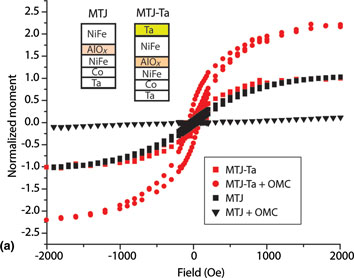Article contents
Nanoscale Tantalum layer impacting magnetic properties of tunnel junction-based molecular devices
Published online by Cambridge University Press: 23 July 2018
Abstract

Magnetic tunnel junction can produce highly configurable molecular spintronics devices. This paper highlights a rather subtle attribute of magnetic tunnel junction fabrication that can lead to the very pronounced impact on magnetic properties of molecular spintronics device. We conducted magnetic studies to observe the effect of depositing ~5 nm Tantalum (Ta) on the top of a magnetic tunnel junction. We investigated the effect of Ta by using characterization techniques like ferromagnetic resonance, magnetometry, and polarized neutron reflectometry. Bridging paramagnetic molecules between the two ferromagnetic electrodes of magnetic tunnel junctions with and without Ta top layer produced the very different magnetic response.
Information
- Type
- Research Letters
- Information
- Copyright
- Copyright © Materials Research Society 2018
References
- 6
- Cited by


